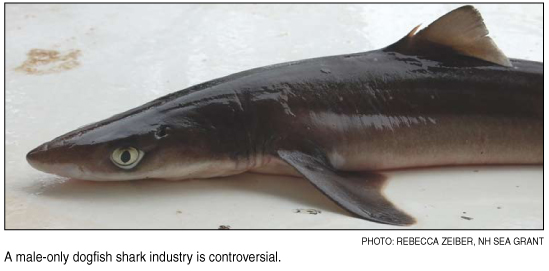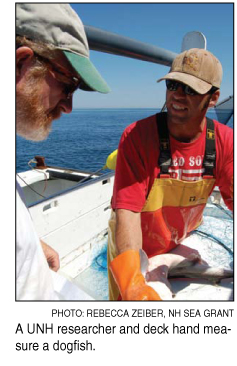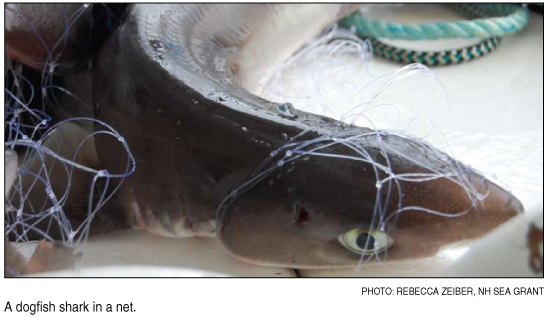*Web only content*
Male-only dogfish shark fishery draws debate
By Rebecca Zeiber
Recent discussions about creating a fishery with only male dogfish in the Gulf of Maine has been met with mixed responses from scientists and fishermen alike. The number of dogfish has risen steadily, but there are many questions about their sustainability.

About a decade ago, dogfish sharks were difficult to come by in the Gulf of Maine. What had been a prosperous fishery during the early 1990s suddenly came to an abrupt end as catches plummeted, likely due to overharvesting. The targeted fishery for dogfish has since been limited to a bycatch quota.
However, since that time, fishermen and scientists have noted a dramatic increase in the number of dogfish they are finding in surveys and collecting as bycatch.
While conducting gill net studies in the Western Gulf of Maine closure area near Jeffreys Ledge last fall, University of New Hampshire research professor of zoology, Ray Grizzle, was amazed at the number of dogfish he was finding.
“It was just incredible,” Grizzle said. “In one 100-foot (more than 30-meter) gill net panel we caught 400 pounds (more than 181 kilograms) of dogfish, which is about 100-120 fish. That’s an average of one fish per foot (0.3 meters) of net.”
 This is far from an isolated incident. New Hampshire Sea Grant commercial fisheries specialist Ken La Valley said that many of the fishermen he speaks with consider dogfish to be a nuisance because they are so abundant. This is far from an isolated incident. New Hampshire Sea Grant commercial fisheries specialist Ken La Valley said that many of the fishermen he speaks with consider dogfish to be a nuisance because they are so abundant.
“They disrupt normal fishing operations on the boats since there are so many to pull out of the nets,” he said. “We’re definitely not having a problem landing them as bycatch.”
Surveys conducted by the National Marine Fisheries Service (NMFS) estimate that there are 700,000 metric tonnes of dogfish in the Gulf of Maine. This is approaching what Paul Rago, a fisheries research biologist from NMFS Northeast Fisheries Science Center Population Dynamics Branch, calls the “biological rebuilding level,” where species might be able to withstand directed harvest.
However, there is a problem. The sex ratios need to be two females to one male, but currently the ratio is closer to one female to five or seven males. Scientists are unsure of why the sex ratio is out of proportion, but it may indicate a problem with the population being unstable.
La Valley noted that creating a fishery of male-only dogfish could help get the sex ratios back in balance and could also help to decrease their numbers in the Gulf of Maine.
“The large number of dogfish could be using up resources needed to help other threatened species increase their populations,” he explained.
Rago earlier this spring presented biological data collected by NMFS at a meeting for fishermen and other stakeholders from Maine and New Hampshire. He was particularly concerned about the decline in juvenile dogfish numbers, which could potentially leave the species vulnerable to a population crash if overfishing occurs. The lack of information about why juvenile numbers are so low is contributing to the hesitation to create a directed fishery.
Aside from the biological issues involved, there are other concerns about the feasibility of creating a male-only fishery.

“Fishermen in general like the idea of decreasing the number of dogfish out there, but the cost of a directed fishery for them might not be worth the cost involved,” La Valley explained.
With the continued increase of fuel and dock costs, along with the relatively low profits that might be generated from the dogfish, many commercial fishermen might not find it economically feasible to target the species. A stable market needs to be available to make the effort worthwhile.
If the decision is made to create a male-only dogfish fishery, a regulatory framework will need to be put into place, La Valley added. This process could take a couple of years and might require special permits to be distributed. These issues further exacerbate the confusion over creating a male-only fishery.
Further discussion on this topic will take place in the coming year. A transcript of the recent discussion and Rago’s presentation is available through the Gulf of Maine Research Institute Web site.
Rebecca Zeiber writes for New Hampshire Sea Grant in Durham, New Hampshire.
For more information visit:
Seafood Facts (NOAA)
Massachusetts Division of Marine Fisheries:
http://www.state.ma.us/dfwele/dmf/
and http://www.mass.gov/dfwele/dmf_old/dmfdogfs.htm
DFO Atlantic Fisheries (Canada)
Canadian Shark Research Laboratory
|








